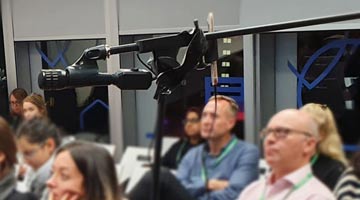By Gemma Pettman

If you have thought about livestreaming your events and activities but don’t know where to start, the CIPR Not-for-Profit Group’s recent experiences may give you the confidence to try it for yourself.
Earlier this year a small group of volunteers got together to revive the CIPR Not-for-Profit group, which had been inactive for some time. While we have PR and the non-profit sector in common, we’re a mix of in-house, freelance, part-time and full-time comms folk, who are spread quite far and wide across the UK. In an effort to make our monthly committee meetings as easy for as many people to attend as possible, we hit on the idea of using the video conferencing tool, Google Hangouts. This enabled committee members in the South West, Midlands, and even as far afield as Scotland to participate as easily as those based more locally.
With that working well for our internal meetings, we decided to offer a Hangout option for our first event back in the summer. Guests from across the UK were able to watch online as Alan Jones from PA and Jess Austin from metro.co.uk shared their advice on pitching to the press. Feedback was positive and remote members welcomed being able to take part from the comfort of their sofas.
Streaming our sessions has quickly become an important part of our approach. Around half our members are based outside London so while we may hold our events in the capital, we know we need to extend our reach beyond the city.
Our most recent event,
Digital on Different budgets, was hosted by Workplace for Good, the tool from Facebook which helps organisations to build their communities and improve communication. This time around we used Facebook Live to stream the event.
Firstly, we set up a private Facebook group and people were asked to confirm their Eventbrite booking number to gain access. Immediately before the event we were able to upload the panellists’ slide decks to the ‘Files’ section of the group, meaning remote viewers had access to exactly the same information as those in the room.
In terms of equipment, we were in one of Facebook’s premises so of course we used their amazing state-of-the-art audio visual equipment, didn’t we? No. In fact, we did the exact opposite. Our host Beth Murray, Program Manager for Workplace for Good, suggested we take a very low-tech approach to demonstrate to our members how simply and cheaply livestreaming could be done. We used a handheld digital condenser microphone on a stand, similar to this. The mic was connected directly to an iPhone, which sat in a smartphone holder (Joby do some great ones for around £20). We gaffer-taped the holder to the stand to be doubly sure it wouldn’t move. The total cost of the kit (minus the phone) was under £150.
Again, feedback was positive. We had a very stable internet connection, so the quality of the stream was good, and viewers were able to pose questions and make comments within the Facebook group, which were then relayed to the panel and audience.
Once the livestream was over, the video was made permanently available within the group, which was helpful for those who missed it or who wanted revisit key points.
Not only have we kept the Facebook group live for future events, we have also bought the microphone and stand. So many of the venues we considered for the event didn’t have the technology to enable us to stream; owning our own equipment overcomes that problem.
There were several other learning points which may be helpful to share:
• We set up a Facebook group as firstly, we don’t have a Facebook page, but more importantly, the event was only available for people who had pre-booked and the group was a way of managing participation.
• Use your group/page to best effect: we uploaded the speakers slides to the ‘Files’ section but you could also post a set of frequently asked questions, or perhaps a summary of the event.
• Testing, testing: we did a dry run shortly before the event started so we could experience what our remote viewers could see and hear.
• We positioned the mic and phone so the full panel was visible and the view remained static throughout the event. Next time we might try focussing on each individual speaker in turn to create a bit of extra interest for viewers at home.
• Had we had an extra volunteer available, we would have monitored and encouraged the conversation in the Facebook group via a laptop or another phone. Trying to like and respond to questions as they came in on the phone we were using for the livestream proved a little tricky, but we managed it.
• Our panellists were great at remembering to look towards the phone, and our chair Helen Reynolds, directed several comments and questions towards our online viewers. This was important to help those at home feel like they were part of the event.
• If you’re going to livestream an event, think about how you can use the content afterwards. We’re working with the CIPR to find a way to make the video available to the wider membership to use as a CPD tool. You might decide to transcribe the full discussion, turn the material into a blog or a help sheet, or create an infographic based on the key points.